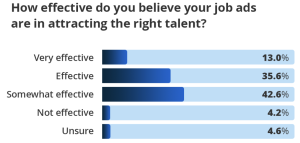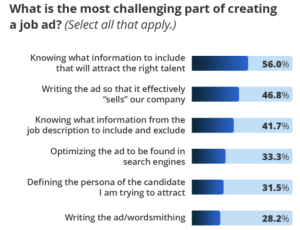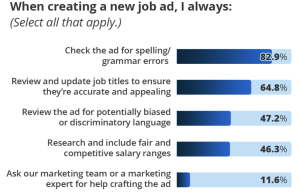You can’t hire talent without a good job ad – but most aren’t very good, according to new research:
If you want great talent to walk through your door, there’s no getting round the fact that you have to go out and attract them first.
And to do that, you still need a compelling job ad – one that excites, intrigues and elicits a positive response all at the same time.
It’s a difficult juggling act. Over-sell your organization and new joiners can be met with a rude awakening when they realize it’s not quite as good as it seems [recent research amongst millennials and Gen Z in 2022 by The Muse found a whopping 72% of people starting a new job and felt a sense of surprise or regret that the role or company was very different from what they were led to believe].
Under-sell yourself however, and it’s the opposite effect – low applicant numbers, and/or not the applicants you really wanted either.
If you don’t know which approach your organization tends to default to, don’t worry, it seems you are not alone.
New data from iHire reveals a rather sobering statistic that only 48.6% of employers think their job ads are ‘effective.’

Well crafted, and captivating they are not, claims the research, which also finds most job ads (38%) only get between 10-30 minutes’ worth of attention to their creation.
Nearly 15% of ads get even less time (less than ten minutes), and just 3.7% get more than it takes to watch the average-length movie.

But it seems it’s not just time that is the issue. “Finding the time to write a job ad, was not as big of a struggle as knowing which information to include to attract the right talent,” says Kristina Kelly, brand manager, iHire. She adds: “This was the top challenge respondents cited – at 56.0%.”
Beyond knowing what to include, the next highest challenge recruiters cited was writing an ad that ‘sells’ the company (46.8%), followed by knowing which parts of the job description to either include or exclude (41.7%) – an concern no-doubt linked to being worried about which elements best sell the job and the organization.
There are certain elements the research finds recruiters do typically include. The majority of respondents said they always include candidate requirements and qualifications (78.2%), location of the job (76.4%), and benefits (63.4%). Nearly half also put on their company logo.
To help them achieve this, some job-ad writers will use templates where they edit-in details of that specific new job – but the data finds it’s not the majority that even use a template. iHire finds that only 42.6% do use a template. A third (32.4%) do not, and a quarter (25%) only use one sometimes.

The upshot of all confusion is that just 13% of employers questions thought their job ads were ‘very effective’.
The finer details
Salary ranges, location and benefits are the simple, fact-based elements that are easy to incorporate into a job ad.
But what appears to be causing problems for recruiters are the ‘softer’ factors required to draft an illuminating ad.
Many (31.5%) say they struggle to define the persona of candidate they are trying to attract, and as such, 28.2% say the required ‘wordsmithing’ to confidently convey this doesn’t always come off.

AI – it seems, is still not being widely used to help here. Despite numerous providers developing tools which they say will highlight how existing copy can be improved to elicit a better response [TLNT recently reviewed one job ad creator here], the research shows just 10.2% use AI (like ChatGPT) to assist in creating their ads “always” or “most of the time.”
Recruiters aren’t always helping themselves
Saying job ads aren’t effective is one thing, but the people who write ads aren’t doing themselves any favors, by admitting to some serious omissions.
While most employers said they checked their ads for spelling and grammar errors (82.9%), other checks still aren’t consistently done. Said Kelly: “We were surprised that less than half of respondents said they reviewed their ads for potentially biased or discriminatory language (47.2%) – which can be a major candidate turn-off.”

Moreover, the data shows that nearly half (49.1%) of employers do not track any metrics – such as view-to-apply rates, application completion rates, and total applies – to determine how well their job ads are attracting qualified candidates.
And, on top of this, 46.3% of employers do not ensure their ad follow SEO best practices so the right talent finds them in search results.
What jobseekers are saying
A couple of years ago, job site, Monster, did its own dive into the biggest job-ad turnoffs, and surprise, surprise, the things they came back with were ‘cliched job descriptions’ [using phrases such as ‘self-starters’ and ‘hit-the-ground-running’] or creating job titles that applicants simply didn’t understand. It found that 64% of people wouldn’t even bother applying for a job if they didn’t understand the title.
Spelling errors also came out as a big no-no [23% of people it surveyed complained about spelling mistakes in ads], as did setting out confusing skills requirements. Use of meaningless jargon was also a detractor: some 57% of respondents it spoke to said jargon in job ads puts them off applying for a role; while three-in-five said they found it annoying, 1 in 3 said it’s confusing and 14% said it’s intimidating.
The worst sectors for using jargon, it was, were media and marketing (85%); management consulting (82%); sales (80%) and banking (79%).
So, in this New Year, should companies be setting themselves a resolutions of writing better job ads?
If they want to get the talent they say they so desperately need, then this would seem like a worthy pursuit.
So what can be done to improve ads?
Kelly gives her thoughts below:
- Highlight information that sells the position: The best job postings include the salary or salary range, benefits, company culture details, EOE statement, and anticipated hiring timeline.
- Ask your marketing teams for assistance: Marketing experts can help with ‘wordsmithing,’ formatting, employer branding, and more elements that make your ad enticing. Marketers can also help you write your postings with SEO in mind using the right keywords will ensure your ad is found by candidates in search engines and on job boards.
- Tap into generative AI tools to save time creating templates: Even if you are unsure how to write a job ad. AI can also proof read your work and help you research salaries and job titles to ensure your ad is fresh and relevant.
- Lean on data to determine your ad’s efficacy: Click-to-apply rates, view-to-apply rates, ad impressions, application completion rates, time-to-fill, total applies, and percentage of applicants who are qualified are a few metrics you should be tracking.
What the data says:
- 20% of jobseekers say they would quit within a month if their new job isn’t what they expected
- Another 41% would give a new job just two to six months before quitting
(source: CNBC Make It)
